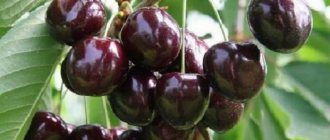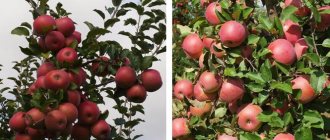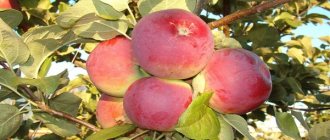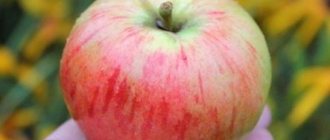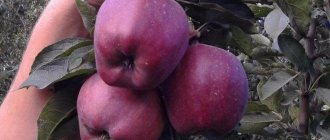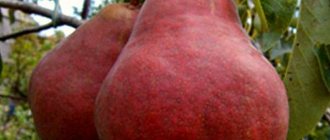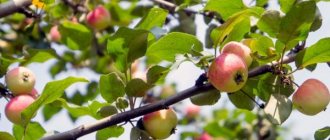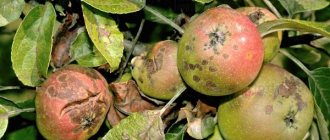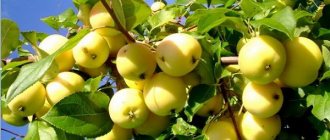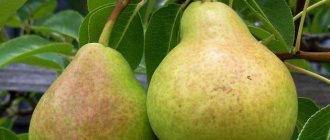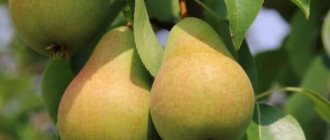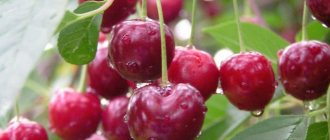History of variety development
The breeding of this cherry variety was carried out by breeders from the Federal State Budgetary Institution All-Russian Research Institute of Lupine, located in the village. Michurinsky of the Bryansk region, A.I. Astakhov and M.V. Kanshina, who were recognized as the authors of the Bryansk pink cherry variety.
Photo of Bryansk pink cherry
This variety is a seedling of the Negritenek variety (now called Muscat Black).
The new cherry was sent for testing in 1987, and after 6 seasons
in 1993, the cherry was included in the State Register and given the name Bryansk pink.
Experts recommended growing a new tree in the Central region.
Harvesting and storage
The Bryansk pink cherry variety has a late ripening period, so harvesting lasts from the end of July to the first ten days of August inclusive. Pick the berries together with the stalk to significantly extend the shelf life of the fruit. You can also collect them before they are fully ripe and immediately place them in the refrigerator at a temperature of up to +4 °C.
Try to select for storage only high-quality, smooth fruits without any visible damage: dents, rot, holes eaten away by pests. Damaged berries should be eaten or processed as soon as possible, because they cannot be stored for more than one day.
Fresh cherries in good condition can be kept fresh in the refrigerator for almost 2 weeks. You should not put them in a plastic bag; it is better to take plastic containers, without closing them hermetically so that the berries do not rot, but covering the container from time to time for 20–30 minutes.
The fruits of the Bryansk pink cherry are good in fresh, frozen, dried form, as well as in processing into jam, jam, compote or juice.
Bryansk pink cherry: main characteristics and description of the variety
This cherry variety is not characterized by high growth of the central trunk - Bryansk pink can reach no more than 3.2-3.6 m in height. The crown of the tree is wide-pyramidal, but quite compact, the skeletal branches are slightly raised upward and are located at an acute angle to the central trunk. The color of the smooth bark of the central trunk is gray.
The shoots are smooth, slightly curved, with a smooth bark surface and brown color. The buds are medium in size, ovoid in shape, they are located at an acute angle to the shoots. Smooth, shiny foliage is less than medium in size, with a rounded base and a pointed tip, without pubescence, with small serrations along the edges. The color of the leaves is deep emerald.
Description of culture
Bryansk Pink Cherry is a medium-sized tree that forms a raised crown of moderate density in the shape of a pyramid. The height of the Bryansk Pink cherry tree can reach up to 2-3 m. The shoots are straight, brown in color, and have a smooth surface.
The plant is decorated with large flat green leaves with concave edges and a pointed tip. The plant pleases with its flowering in May. A special feature of the variety is its delicious berries, which are poured at the end of July. The fruits are formed both on bouquet branches and 2-3 pieces on annual shoots. The weight of one fruit is 5 g.
Cherries are round in shape, covered with pink or yellow skin, through which you can see the speckled pattern. The pulp is light yellow in color and characterized by elasticity. The stone is colored light brown and is small in size and is difficult to separate from the pulp. Long stalk of moderate length. The separation from the pulp is dry.
More information about the Bryansk Pink cherry:
Pollinator trees for Bryansk rosea
This cherry variety, like some others, is self-sterile, so for its pollination it is necessary to plant nearby other varieties of these fruit trees, which bloom at the same time as the Bryansk pink one. Without the presence of pollinators, the yield of this variety is practically zero.
The best pollinators for Bryansk pink cherries are:
- Revna;
- And the way;
- Tyutchevka;
- Ovstuzhenka.
Important!
You should not plant different fruit trees mixed in your garden plot; it does not look very aesthetically pleasing, and in addition, it interferes with cross-pollination of the same types of fruit trees, in particular, cherries. Therefore, pollinators should not be planted far from the cherry tree - their mutual pollination will be difficult, and as a result, the yield will suffer.
Reviews from summer residents
Over decades of cultivation, owners of the variety have generally formed a positive opinion:
Matvey, Moscow region : “I would argue about the sustainability of Bryansk pink. Of the four cherries, one suffered from moniliosis, but the disease developed mainly due to an expired fungicide. This is most likely a feature of the tree that may have suffered the most from the cold season. Overall, I was pleased: the variety proved to be the most prolific.”
Svetlana, Khabarovsk : “The variety has proven itself well in our conditions, it is really unpretentious and does not freeze. I would like higher yields, but the advantages are immeasurably greater.”
Irina, Ryazan : “I have a tree in my garden for 10 years, there are pollinators nearby. The yield is stable, although the berries are small, but we have enough. I feed as needed, water 3-4 times per season. I recommend!".
Productivity of the variety
Bryansk pink cherry is a late variety, so these fruit trees bloom in the second ten days of May. During this period, returning spring frosts are relatively rare, so the blossoming flowers on cherry trees are almost not damaged by the cold.
This cherry is not early fruiting
– the first fruits can be collected from the tree only in the 5th year of life.
Bryansk pink cherries cannot boast of high yields - approximately 20 kg of ripe products are collected from each mature tree, and only in a favorable season its yield can increase to 35-40 kg.
When growing Bryansk pink cherries on an industrial scale, up to 53-55 centners of ripe berries are collected from 1 hectare.
Bryansk yellow cherry
The Bryansk yellow cherry was bred at the All-Russian Research Institute of Lupine. This is a low tree that bears fruit in medium terms. The fruits are large, dense, yellow, weighing 4-5 g. The pulp is yellowish in color, the juice is colorless. Universal variety: suitable for fresh consumption and canning. Cherries do not crack, are stored for a long time and are easily transported. Bryansk yellow is resistant to diseases and frost. Even after a harsh winter, freezing of fruit buds does not exceed 10%. The variety is self-sterile, suitable pollinators: Tyutchevka, Iput, Revna, Ostuzhenka. Fruiting begins 5 years after planting.
Diseases and pests
It should be noted that this variety of cherries is practically not affected by coccomycosis, moniliosis, and klyasterosporiosis, and the Bryansk pink berries are not susceptible to rot.
Of the pests, the most important enemy of this cherry is aphid.
which can be combated with folk remedies or with the help of insecticides.
Photo of the cherry pest - aphid
Rules of care
The stability of fruiting and the sugar content of berries depend not only on the genetics of the tree and planting, but also on further agricultural technology, including irrigation, fertilizing, care for the tree trunk and crown of the cherry tree.
Top dressing
Bryansk pink is fed twice a season. In the spring, 200 g of urea is added for the first loosening, after which the tree is watered. The crop is fed a second time in August after fruiting. Superphosphate granules in the amount of 350 g are placed in the tree-trunk grooves and moistened.
Every three years in the fall, before digging, a bucket of manure, humus, and compost is added to the soil around the tree trunk.
Watering
Bryansk pink cherries are irrigated before flowering, after it, during the fruiting period and in preparation for winter. Water the crop through 3 grooves, spaced 40 cm apart. Mature trees will need 4 buckets of water during the growing season, 6–7 buckets during moisture-recharging irrigation.
The seedlings are watered every week in a volume of 10 liters.
Weeding and loosening
To increase aeration and moisture permeability, the tree trunk circle is loosened when a crust forms on the ground, going deeper than 10 cm. Weeds that compete with Bryansk pink cherries for nutrients are weeded as they appear.
Crown formation
In early spring, before the buds swell, starting from the second year, the skeleton of the tree is formed. When creating a sparsely-tiered cherry crown, the first tier is formed from three multidirectional branches, on the second - from two, growing 70 cm above the first tier, in the third year - from one branch at the same step.
In the fourth year, the formation of the tree crown is completed by trimming the branches of the 3rd tiers so that the guide is 20–25 cm higher. On the lower tiers, shoots of the second order are shortened to 70 cm.
Sanitary and regulatory pruning
Spring pruning of Bryansk pink is carried out when the cherry tree is dormant. First, diseased, broken branches of the tree are removed.
The next step is to get rid of intersecting branches growing inside the crown. They are removed completely or cut to a bud that looks outward and not into the crown.
Shoots located at an angle of 45°C or less to the trunk and creating an obtuse angle (looking down) are removed.
Vertical shoots of the crop on skeletal branches (tops), basal shoots that impoverish the soil, and shoots below the first tier are cut out.
If a branch competes with the guide for leadership, the second-order branches on it are removed in the first year, and the skeletal branches in the second.
To stimulate the growth of fruit branches, annual growth longer than half a meter is shortened by a third to the outer bud.
A vertically growing branch can not be cut, but given a horizontal position by tying a rope, the other end of which is secured to the trunk or a stake driven into the ground.
Preparing for winter
Before the onset of winter, to increase the winter hardiness of Bryansk rose, preparatory measures are carried out:
- the cherries are watered abundantly (60–70 l), preventing the roots from freezing;
- loosen the soil by 8–10 cm;
- add superphosphate and potassium sulfate;
- the trunk and skeletal branches are whitened;
- mulch the tree trunk circle with a 5-centimeter layer of manure and peat.
Young trees are covered with burlap and agrofibre. To protect Bryansk pink from rodents, a frame of plastic or metal mesh is built around the cherry tree. For the purpose of snow retention, spruce branches and brushwood are placed around the crop.
Advantages and possible disadvantages
The main advantages of the Bryansk pink variety include:
- high frost resistance;
- good resistance to fungal diseases;
- the harvested crop tolerates transportation well at any distance;
- the fruits are not subject to cracking and are practically not damaged by fungal diseases;
- the berries have a good taste;
- the collected fruits are of universal use;
- restrained tree growth.
But Bryansk pink cherries also have a number of disadvantages that need to be remembered:
- there is bitterness in the taste;
- the fruits are not too large;
- self-sterility of the variety.
Recommendations for harvesting and storing crops
Bryansk pink begins to bear fruit in the 5th year. The variety has a late ripening period. The harvest is harvested at the end of July or the first ten days of August. The average yield is 20 kg, but under favorable conditions you can get up to 30 kg of berries from a tree. The cherries are picked with the stalk, this allows you to extend the storage period of the crop. Also for this purpose, the berries are collected before they are fully ripe, and immediately after collection they are cooled at a temperature of 0–4°C.
Only high-quality fruits should be sent for storage. Cherries with mechanical damage or signs of disease are set aside separately, as they quickly deteriorate.
Bryansk pink cherries make excellent desserts
Fresh fruits are stored in the refrigerator for 1–2 weeks. Berries should not be placed in a plastic bag; for this it is better to use trays . It is advisable to cover the container to prevent the fruit from drying out. However, do not seal the trays as the berries will rot.
Bryansk pink has universal application. Jams, jams, compotes, and juices are prepared from the fruits. The berries are also consumed fresh, frozen and dried.
How to plant Bryansk pink cherries
Growing Bryansk pink cherries is not too difficult, but you need to choose the right place for planting, as well as provide proper further care.
Photo of cherry planting scheme
First you need to check how acidic the soil is in the garden plot where the cherries will grow. It's good if there is a litmus test. With which it is very easy to check the pH of the soil. But you can do this with regular vinegar. A little soil is taken from the garden (it is dug out of a hole 30-40 cm deep), ordinary window glass is placed on a black, flat surface, and the soil is laid out on it. A little table vinegar is poured on it. If the soil is acidic, no chemical reaction will occur. On neutral soil, a little white foam will appear, and alkaline soil will “foam” all over.
It is better to select a place for planting this cherry in the southern or southeastern part of the garden - there the tree will be constantly illuminated by the sun's rays.
Photo of cherry blossoms
Important!
When growing cherries in the shade, you need to know that in such conditions the tree will develop worse, and the fruits will not gain the required amount of sugars.
It is best to plant Bryansk pink cherries on a small hill, where they will still be sheltered from gusts of cold wind.
In small garden plots, gardeners plant cherries, to which several varieties have been grafted with the same flowering periods. In this case, they cross-pollinate each other and bear fruit regularly.
Photos of growing Bryansk pink cherries
Bryansk rose requires loose, fertile soil that perfectly allows moisture and oxygen to pass to the roots of the tree.
Heavy clay and sandy soils are not suitable for this variety of cherries, unless they are improved - add a large amount of humus or compost to sandy ones, and sand and humus to clayey soils.
When choosing a cherry seedling, you should pay attention to the following nuances:
- the tree must be two years old; older seedlings should not be purchased;
- the roots of the plant should be well developed, there should be at least 4 of them, and the length should be about 25 cm, without growths or compactions;
- you should make sure that the bark of the trunk and shoots has a uniform color, it is smooth and even, without signs of damage;
- tree height – no more than 1 m.
Before planting, the seedlings are placed in a container of water to which Kornevin is added to disinfect the tree.
Bryansk pink cherries should be planted in early spring before sap flow begins, or in late autumn after leaf fall. The soil for planting is prepared in the fall (if it will be planted in the spring) or about a month before the autumn planting.
The area for planting must be dug up, first adding 6 kg of compost, 1 tbsp. l. potassium chloride and 1.5 tbsp. l. superphosphate. Dolomite flour or lime is added to soil that is too acidic.
Planting cherries - video
Bryansk rose should be planted immediately and a couple of pollinator trees nearby. For each tree, they dig a hole with a diameter of 0.8 m and a depth of 0.6 m. The distance between adjacent holes is 3.5-4 m. The distance from the fence or garden buildings should be the same.
Before planting, add 5-6 kg of clay to sandy soil, and the same amount of sand to heavy soils.
A nutrient substrate is added to the sandy soil - garden soil mixed with 10 kg of rotted mullein, 2 tbsp. l. potassium salt and 1 tbsp. l. superphosphate. This amount of fertilizer should be enough to fill the hole to about a third of the depth.
INTERESTING!
The best ways to propagate black currants
A peg is driven in near the center of the hole, to which the tree will be tied until it is completely rooted.
The seedling is placed in the center of the hole, the roots are straightened along its diameter and the hole is filled with earth, compacting it well. Under each tree you need to pour 35-40 liters of water.
Planting cherries and pollinating varieties
The self-sterile Bryansk pink cherry will produce a harvest only if it is in close proximity to simultaneously flowering cherry trees of other varieties. The best pollinators for it are:
- And the way;
- Ovstuzhenka;
- Revna;
- Tyutchevka.
Sweet cherry cannot be pollinated by cherries, but is a good pollinator for some varieties of cherries.
Self-sterile cherries bear fruit only in the presence of a pollinating variety.
Selecting a location
Cherry is very capricious in relation to soil conditions and microclimate of the site. Not at all suitable for growing it:
- heavy clays;
- peat bogs;
- areas with high (closer than 2 m from the surface) groundwater;
- northern slopes;
- areas open to all winds “in an open field”;
- lowlands and depressions with stagnation of cold air in the winter-spring period.
The most favorable conditions for cherries:
- old gardens in the city (it’s always warmer there than outside the city);
- areas with a slight gentle slope to the south;
- location of the site on the south side of the forest edge or protective forest belt.
Planting cherries near the southern walls of buildings and high solid fences has its pros and cons. Plus, it provides good protection from cold northern winds. The downside is the premature melting of snow in early spring, which causes the buds to begin to open too early, subject to return frosts. If the distance from the tree to the wall is less than 3–4 m, growing roots can damage the foundation.
Cherry is light-loving and does not tolerate excessive dampness. The soil for it should be loose, sandy loam or loamy, with good drainage and neutral (within 6–7) acidity.
Sweet cherries bear fruit well only under favorable soil and climatic conditions
Selection and purchase of seedlings
Buy and plant cherries only in spring, from late April to early May. A good seedling has healthy bark without damage, live buds and light wood when cut. It is advisable to purchase seedlings with a closed root system. Choose a nursery in your region or further north. Random sellers at a roadside bazaar will only have southern seedlings “without clan without tribe.”
Seedlings from the southern regions in the Moscow region freeze out, regardless of the variety!
Prepare planting holes (about 70x70x70 cm in size) in the fall. The distance between trees is 3–4 meters.
Step by step process
- Secure a stake in the hole to secure the seedling.
- To the soil removed from the pit, add 3 buckets of completely rotted manure or compost, a liter jar of wood ash, one bucket of coarse river sand (the latter for loamy soils). Mix well.
- Pour the resulting mixture into a mound at the bottom of the hole.
- Place the seedling on a mound, carefully straightening the roots. After planting, the root collar should be slightly above ground level.
- Carefully fill the hole with the remaining soil mixture, compacting it gently.
- Make a hole for watering. Gradually pour 2-3 buckets of water into it.
- After the water has been absorbed, mulch the hole with humus or straw.
- Tie the seedling to a stake.
When planting, do not bury the root collar of the seedling.
Tips for planting crops - video
Further care for Bryansk pink cherries
In the first season, you need to water young trees every 6-8 days, and also make sure that the top layer of soil does not dry out. It is enough to pour no more than 10 liters of water into the seedlings per watering.
Adult cherries are watered according to the following scheme:
- during the budding period;
- during flowering;
- during the fruit harvesting period;
- during the dry season, you can water the cherries in September.
Watering is carried out with warm filtered water. After each watering, it is necessary to loosen the tree trunk circles and at the same time remove all weeds.
How to properly plant and care for cherries - video
[media=
https://youtu.be/mB83bSck0po
]
Tree feeding
In the first season after planting, cherries are not fed
– the fertilizers that were applied during planting are quite enough for her.
In the following seasons, three times during the summer,
a urea solution is added to the tree trunk circles, diluting 30 g of the drug in a bucket of water. The interval between applying these fertilizers is 10 days.
From the fourth season, cherries are fertilized in spring and autumn.
In the spring, 150 mg of urea should be added to each tree trunk circle, and in the autumn - 1 cup of potassium sulfate and 2.5 cups of superphosphate.
How to feed cherries - video
From the beginning of fruiting in the spring, 2.5 cups of superphosphate are applied to these fruit plants, and in the fall they are applied with the following mixed fertilizer:
- 1 glass of potassium salt;
- 2 cups superphosphate;
- 45-50 kg of humus.
How to properly prune Bryansk pink cherries
The crown of the cherry tree should be formed from the second season of its life.
Typically, the shape of such a tree is sparsely tiered. 3 skeletal branches are left in the first tier, 2 in the second, and 1 in the third.
Photo of the cherry crown formation diagram
also carry out sanitary pruning of Bryansk pink,
removing all damaged, dry, frozen shoots growing inside the crown.
All cut areas must be lubricated with garden varnish.
Forming cherries - video
Subsequent care of the crop
Caring for Bryanskaya Pink cherries involves taking measures aimed at ensuring the survival of the seedling after planting and creating comfortable conditions for growth.
The characteristics of the Bryanskaya Rozovaya cherry variety require the implementation of such care measures.
Compliance with soil moisture conditions
The main process is high-quality watering, which determines the growth rate of the tree, the weight and quality of the fruit. Therefore, you need to water moderately. The frequency of irrigation is determined by weather factors, soil type and the age of the fruit trees grown.
Proper pruning
For the aesthetic beauty of the Bryanskaya Rozovaya cherry variety and to obtain a quantitative and high-quality harvest, it is necessary to carry out pruning. In the first years of life, it is necessary to trim the shoots to stimulate fruit formation. In the future, only dry, damaged branches that weaken the tree should be removed.
Fertilizer application
After planting, Bryansk Pink cherries do not need to be fertilized with fertilizers, since excess nutrition can provoke very active growth of shoots that do not have time to grow stronger during the summer and freeze in the cold period.
Later in the fall you can fertilize with ash and manure. After 5 years, add slaked lime to the soil, evenly distributing it in tree trunk circles. Feed mature fruit-bearing trees with urea in the spring, and add saltpeter and superphosphate in September.
Preparing for winter
In the autumn, you need to rid the plant of fallen leaves. Then dig up the soil in the tree trunk circles and mulch using organic matter. This will retain moisture in the soil and prevent it from freezing. And to protect Bryanskaya Pink cherry trees from rodents, the trunk must be covered using roofing material, spruce branches, and plastic mesh.
Diseases and pests, methods of control and prevention
Diseases can reduce the quantity and quality of the harvest and cause the death of Bryansk Yellow cherries and Bryansk Pink cherries, and pests will take away the long-awaited harvest, as they love to eat delicious berries. Therefore, it is important to identify the first signs of a problem in time and promptly take appropriate measures.
| Diseases | ||
| Name | Description | Control and prevention measures |
| Brown spot | The presence of dark spots on the leaves | Spray the plant before buds open using 1% copper sulfate |
| Gray rot (moniliosis) | Cherry shoots turn brown, wither, and small grayish growths appear on the fruits, which are randomly located | Destroy the affected parts of the plant. Before and after flowering, spray the plant and soil with copper sulfate or 1% Bordeaux mixture |
| False tinder | White rot appears on the wood, which softens the wood and makes it soft. Such trees are easily broken by the wind | The infected plant must be dug up and burned. For preventive purposes, it is necessary to whitewash the trunks, disinfect wounds and cracks with 3% copper sulfate |
| Pests | ||
| leaf roller | In the spring, leaf roller caterpillars bite into buds and buds and entwine them with cobwebs. Then they move on to foliage, and in case of high numbers, to berries | Treat with insecticides. You can resort to folk remedies by using tobacco tincture or wormwood decoction |
| cherry fly | The presence of dark, rotten fruits, which subsequently separate from the stalk and fall off, signals that larvae have appeared in the berries and feed on the pulp. | Treatment of the plant after flowering with the drug "Fufanon", with a huge number of insects, it is necessary to re-treat it, but no later than 20 days before the berries ripen |
| Black cherry aphid | The insect feeds on the sap of leaves, which subsequently stops growth, curls, turns black and dries out. | Spray with soap solution, infusion of ash, and also get rid of ants, which are considered carriers and guardians of aphids |
If all control measures are followed, the crop will be preserved and suitable for food use.
Bryansk pink cherries: reviews from those who grow them
Olga, 45 years old, Moscow region: Bryansk pink cherry has been growing in my garden for 7 seasons. I can argue about fungal diseases. This season I treated the trees with expired Horus, but only this cherry caught moniliosis. But it is quite possible that this is not a property of the variety, but only of this particular tree. But in general, I am satisfied with this variety of cherries - good yield, excellent taste of the fruits, no special complex care is required.
Natalya, 50 years old, Bryansk region: In general, the variety is not bad, but the ripe berries are too small, and the taste rating of Bryansk pink from tasters is rather low - only 4 points.
Irina, 47 years old, Ryazan: This cherry variety has been growing in our garden for almost 10 years, and there are a couple of pollinating varieties nearby. The yield is excellent, we fertilize as needed, and only need to water a few times a season. I recommend!
Bryansk pink cherries delight with their productivity, resistance to frost and disease, and the excellent taste of the fruit, which is why gardeners from the Moscow region, the middle zone, the Central region and other regions with similar climatic conditions are so willing to plant them in their gardens.
Growing technology
The survival rate of the crop depends on the correct choice of planting material, location and preparation.
The tree is bought from a nursery to avoid fraud with the variety and not to lose the plant after the first winter . Select a two-year-old seedling without cracks or damage, with live buds and a light cut at the top. The exposed roots are wrapped in a damp cloth and wrapped in film. This will protect the plant from dehydration during transportation.
Optimal conditions
When planting, take into account suitable climatic conditions and late fruiting of the variety . If the seedling is purchased in late autumn, it is buried. Cherries, like all stone fruits, are best planted in the spring, even if the plant is in a container.
Landing dates and rules
Cherries are planted before buds begin to open and sap flows . In the Central region, the deadline falls on the first half of April. At this time, the ground is completely thawed, and the threat of serious frost is minimal.
A place is selected that is well lit and protected from the wind, especially from the north . The ideal would be a gentle slope, an area near the south side of the house or a solid fence, where there is no stagnation of melt water. Maintain a distance of 3-4 m from the foundation or tall trees. When mass planting, wide passages of 5-6 m are made.
The variety develops favorably on loose neutral sandy or loamy soils with good drainage and a low groundwater threshold.
Important! For the formation of an ovary, at least 2 pollinators are required nearby - other types of cherries. Cherry and elderberry will be successful neighbors. It is not advisable to plant Bryansk pink next to apple, pear, currant, raspberry and nightshade trees.
The planting site is prepared in the fall or spring, 3-4 weeks before work, as follows:
- Dig a hole 60–70 cm deep, 70–80 cm wide and long.
- The soil is mixed with 2 buckets of humus, 4-5 handfuls of ash and 100 g of superphosphate and transferred back.
- The clay soil is dug a little deeper and broken brick or crushed stone is placed at the bottom.
- Drive in a peg for support.
- If the weather is dry, add 2 buckets of water to better dissolve the nutrients.
Before planting, the cherry roots are placed for 2-3 hours in the “Kornevin” solution for better survival. Further:
- Part of the soil is removed from the hole.
- Place the seedling so that the neck comes out of the ground a few centimeters, straighten the roots.
- Gradually rake the soil, compacting the layer with your hands each time. At the end, a roller is formed around it.
- The trunk is tied to the stake with a figure eight knot.
- Pour out 2-3 buckets of water and mulch with humus.
For large seedlings, pruning is done at a height of 60–80 cm from the ground.
Further care
Caring for the variety is standard for cherries . Seedlings 2–4 years old are given 2 buckets of water every 3 weeks. To prevent crust formation, the soil is loosened and mulched in a timely manner.
Mature trees are given a moisture charge 4 times per season: before and after flowering, 2 weeks before harvest and in the fall. Pre-winter watering is important as it will help survive frosts.
In the spring, to stimulate shoots, 100–150 g of urea is evenly applied to the tree trunk circle, which is embedded shallowly. After fruiting ends, the plant is fed with 300 g of phosphorus and 100 g of potassium.
Attention! The crown is formed over the next few years. Further pruning will be for sanitary purposes only. The variety is not prone to thickening; only the branches rubbing against each other are cut out inside. Even minor wounds are covered with garden varnish.
Possible problems, diseases, pests
The variety is resistant to the most common crop diseases, but cool and rainy summers cause outbreaks of phyllosticosis, the appearance of false and sulfur-yellow tinder fungi. Dangerous pests include aphids, leaf rollers, and cherry moths.
Spraying with 1% Bordeaux mixture before buds open and after picking berries helps against fungus. Insects are destroyed with insecticides: “Aktellik”, “Karate”, “Karbofos”.
Wintering
Bryansk pink is not afraid of frost, but it will not be superfluous to prepare it for winter . The procedure will help protect against pests, spring burns and rodents.
Stages of work:
- Clear the tree trunk circle of leaves and weeds.
- Dig the soil to a depth of 10 cm.
- The trunk and a third of the lower branches are whitened with a composition of 5 liters of water, 1 kg of lime, 100 g of copper sulfate and 500 g of powdered clay. For young trees, the concentration is 2 times less.
- Mulch with a thick layer of sawdust and peat. The trunk is wrapped in burlap or spruce branches.
Reproduction
The grafting method is suitable for propagation . When growing a tree from a seed, varietal characteristics are not preserved. The cuttings are grafted onto a young seedling. He will repeat the parental characteristics.
The cutting method is rarely used as it is unproductive. In this case, the survival rate is no more than 5%.
How and when to plant
The tree can be planted in spring and autumn. If spring planting is chosen, then all activities should be carried out immediately after the snow has melted and the soil has warmed up slightly. When planting in spring, there is a high probability that the plant will quickly take root before the onset of autumn frosts.
Landing location
Cherries of this variety take root well and bear fruit in those beds where there is excellent sunlight and no cold wind. Then the plant will develop well and bear fruit. You can also plant trees along fences or buildings.
When planting, make sure that one seedling does not interfere with the growth of another. To do this, a distance of 3 m must be maintained between them. But between the rows it will be 5 m. To plant cherries, you also need to choose a slightly elevated place. You can also build a low artificial hill.
Sweet cherries need fertile soil that perfectly allows moisture to pass through and does not retain moisture. So clay and sandy soils are not suitable. But loam is what you need. They are perfectly saturated with oxygen. But how to plant Revna cherries, and what pollinators exist for this variety, is indicated in the article at the link.
The video shows how the landing takes place:
You also need to pay attention to the level of groundwater flow. They must be located at a depth of 1.5 m. If this condition does not persist, then drainage will have to be provided.
If the site has clay and sandy soil, then you can place sand in the first type of soil, and clay in the second. You also need to add mineral and organic compounds. Moreover, soil preparation should be done a few days before planting.
Planting process
To fertilize planting holes, you must use a mixture consisting of the following components:
- Compost – 10 kg;
- Potassium chloride – 20 g;
- Superphosphate – 30 g.
Before planting, young Bryansk pink cherry trees should be cut by 1/3. Place the roots in the planting hole carefully, making sure that the root collar is centered 5 cm above the soil level. It is also worth learning more about the description of the columnar cherry variety, what they are like, and what they look like.
Reviews
- Sergey, 42 years old: “The cherry tree of this variety did not immediately take root on my plot. The first time I planted it in clay soil, I did not use any fertilizer. And then in the spring I discovered that the tree had died. But the second time I took careful care of the fertilizers and today they have a full-fledged and high-yielding tree. The fruits are tasty, juicy, sweet. Since we have a large family, we eat them all fresh.”
- Antonina, 62 years old: “Bryansk pink cherries please me every year with their high-quality and rich harvest. All berries are clean, juicy, without a single defect. But such a high quality of the harvest is due to my careful care. “I constantly monitor the humidity level, regularly fertilize, cover the tree for the winter and carry out preventative spraying against diseases and pests in the spring.”
And here you can read reviews about cherries Valery Chkalov.
Bryansk pink cherry is a unique variety that has become widely known among many gardeners today. Caring for the crop is not difficult, since it does not require special attention, and the harvest is not only abundant, but also of high quality.
Landing dates
As you know, it is generally not recommended to plant stone fruits in the fall, at least as far as the middle zone is concerned. True, recently seedlings are often sold in containers (with a closed root system); It is believed that they can be planted at almost any time. However, in the case of cherries, it is better not to risk such seedlings: the tree should meet the onset of winter, having already completely settled in the new place.
Therefore, regarding the timing of planting, we can definitely say: Bryansk pink should be planted only in the spring. The specific timing depends on the weather: the soil on the site should completely thaw, serious frosts should pass, but the buds on the seedling should be at rest or, at most, just swell. Most often in the Central region, this situation occurs in the first half of April. But, naturally, all preparatory work must be carried out in the fall. If you had to purchase a seedling in the fall, it must be properly buried in the garden until spring.
This is interesting: Sulfur for grapes: methods of using colloidal sulfur to treat plants
